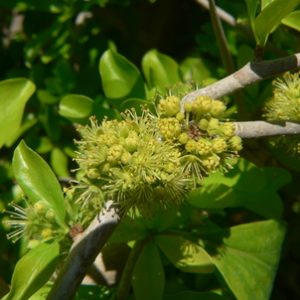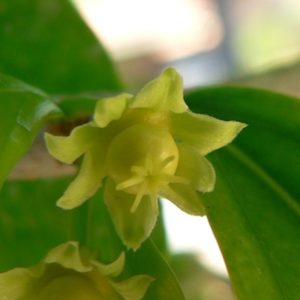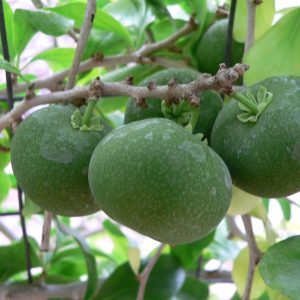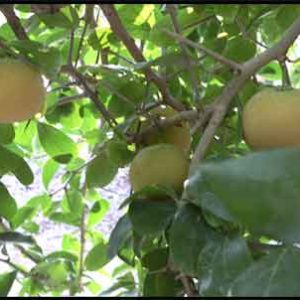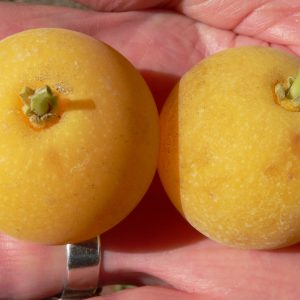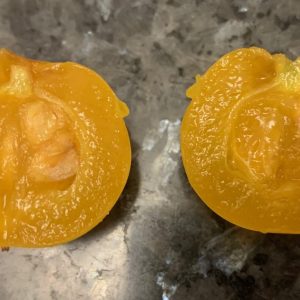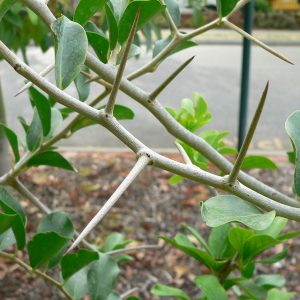Dovyalis caffra
Kei apple, wild apricot
Origin
Native to South Africa.
Climate
This is a hardy sub-tropical species that grows best where mean temperature is within the range 3-45°C and precipitation is 700-1700mm pa. It will also grow in the tropics with sufficient elevation for cooler conditions. It is frost and drought resistant.
Plant Description
A dioecious shrub or small tree, many branched and growing to 5m high in dry environments, 8-9m in wetter conditions. It appears evergreen as old leaves persist till new ones appear. The dark green waxy leaves are almost sessile and occur either in clusters on dwarf side branches or alternate on young shoots. Branches are heavily armed with very sharp thorns up to 3cm long. Plants are allelopathic.
Relatives
Salicaceae Family. Related to Ceylon gooseberry (D. hebecarpa), ketembilla, tropical apricot or dovyalis (D abyssinica X D hebercarpa) and Governor’s plum.
Soils
Undemanding, from sandy to loamy clay provided they are well-drained and aerated with a pH in the range 5.5-8.5. It is a tough species and grows quite well in impoverished soils that would not support cropping with many other fruit trees.
Propagation
Seeds cleaned of all flesh, which contains inhibitory substances, germinate readily. Seedling-grown trees are not true to type and produce fruit with widely varying characteristics; they also produce a large excess of male trees.
Cultivars
There are no established cultivars resulting from systematic development work. However, some plants selected on the basis of favourable attributes such as sweetness are propagated vegetatively, either by cuttings of grafting.
Flowering and Pollination
Flowers have no petals, are inconspicuous, axillary, creamy-green and solitary or clustered. Although plants are dioecious there have been reports of female plants setting fruits in isolation from male trees. One male plant is normally sufficient to pollinate several females within reasonable proximity. The male flowers (3mm long) appear in clusters of 5-10 flowers and the female in groups of 1-3 on peduncles 4-8cm long. The specific means of pollination has not been reliably established, with some reports quoting insects and others wind. Perhaps the petal-less flowers which do not provide a distinct visual cue for insect attraction might suggest wind is the dominant vector.
Cultivation
They are hardy enough to usually be grown without active management apart from pruning.
Wind Tolerance
They can serve as windbreaks.
Pruning
This requires care and thick gloves because of the thorns, as does disposing of the prunings. If trained as a hedge, it forms an impenetrable and dense green barrier down to ground level. Non-drastic pruning seems to enhance fruiting. Skirting is recommended to allow trouble-free collection of fallen fruits on the ground. Trees can also be grown as espaliers, and are suitable to grow in pots.
The Fruit
The juicy fruit is a berry, almost spherical, up to 5cm in diameter, contains 5-10 small seeds and changes from green to yellow-orange with maturity. The flesh has twice the level of vitamin C as oranges, high polyphenol antioxidant levels and 10-15% sugars.
Fruit Production and Harvesting
The juvenile period of seedling-grown plants is 4-5 years whereas those from cuttings may crop within 2-3 years. Trees give regular yields without alternate bearing and fruits mature about 3 months after flowering. They can be picked from the tree, but great care has to be taken with the thorns; it is preferable to wait till they fall to the ground and then they should be collected regularly.
Fruit Uses
Most varieties are acid/tart and therefore are used preferentially in processed forms where, like lemons, they add a zing. Others are sweet enough for eating out of hand after being kept at room temperature until they soften. Acid levels decrease and sugars increase with ripening. The thin, velvety skin is easily removed by hand peeling. Unlike many fruits, once ripe, they store quite well.
Pests and Diseases
Minimal. Fruit flies.
Comments
This is a tough plant that has no problem with our infertile soils and challenging summer conditions. The fruit of sweeter varieties is good and can be produced in abundance. The biggest issue is the thorns, which can be a plus if the tree (or espalier) is used as a barrier/hedge, but a negative whenever pruning has to be undertaken.
